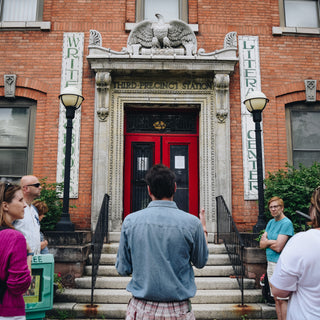Words and photos by Olivia Bauso
I've walked through Neighborhood of the Arts countless times since moving to Rochester, never really knowing what I was walking by. So, last Saturday I joined our "Architecture Tour of NOTA: Then & Now" to #exploreNOTA and its extensive history. Here is a condensed version of what I was able to see and learn on this short -- and action packed -- journey. . .
Axom Gallery and Exhibition Space


AXOM Gallery was established in 2012 and "focuses on contemporary visual art and design from emerging and established artists of influence." It is located on Anderson Ave in the newly named Art & Design building. Now operated by Robin, Rick and Margot Muto, the gallery offers exhibition space for artists in addition to serving as studio space for Robin and Rick's interior design and art businesses.
Long before providing space for artists, the Art & Design building was just another Rochester industrial superstructure: home to Frankel Bros & Co., a wholesale woolen and cotton rag manufacturer. What the housewives didn't buy here in town was bundled and sold to papermakers and textile, fiberboard and plastics manufacturers. There are still markings on the floor from the original warehouse.
Memorial Art Gallery


Memorial Art Gallery was founded in 1913 by Emily Sibley Watson as a memorial to her son, architect James Averell. His initials are marked on the front of the original building. The museum was donated in trust to the University of Rochester and is one of the few university-affiliated art museums in the country that also serves the community.
At the time of it's construction, the University of Rochester was still located on University Avenue. MAG and Cutler Union were two of the few buildings that faced outward to the community, as opposed to facing the middle of campus. This perpetuates the communal nature of MAG's mission. The original blueprint included two lion statues (similar to those outside the New York Public Library), but all that was included in construction were little lion details at the base of the lamp posts.
Established in 2013, Centennial Sculpture Park covers ten acres of the Gallery’s grounds in a showcase of public art and urban space. It aims to connect people with art, again extending MAG's mission. The major artists that contributed to the sculpture garden are Wendell Castle, Jackie Ferrara, Tom Otterness, Albert Paley and Deborah Butterfield (whose bronze horse is pictured above!).
Writer's & Books


Writers & Books is a literary center that promotes reading and writing as lifelong activities. Their programs are for both youth and adult learners and open to students of all backgrounds and abilities. In January 1985, Writers & Books moved from its original storefront location into it's current NOTA location, a former precinct station designed by Rochester illustrator and architect Claude Bragdon.
Claude Bragdon designed five similar precinct stations, three of which are still standing. Though it's original purpose was utilitarian, creative touches can be found all over the building (the use of arches, the addition of keys, charming fireplaces and more!). Claude Bragdon eventually left Rochester after engaging in a disagreement with George Eastman. Writers & Books has kept the outside of the building virtually untouched to preserve the building's charm. They have, however, moved what use to be the door to a cell to side of their building, adding a bit of mystery to the landscape.
George Eastman Museum


The George Eastman Museum is the word's oldest museum dedicated to photography. Renowned for its photograph and motion picture archives, the museum is also a leader in film preservation and photograph conservation. The museum is located on the estate of local legend George Eastman, founder of Eastman Kodak Company. The estate was designated a National Historic Landmark in 1966, following its charter as a museum in 1949.
George Eastman built his estate on 900 East Avenue between 1902 and 1905. The property has been home to working farm land, formal and informal gardens, greenhouses, stables, barns and pastures in addition to the 50-room colonial revival mansion. Eastman lived on the estate with his mother and oversaw several renovations to the property during his time there. The house was redecorated so many times that when the museum asked for gifts from the house to be returned, there were too many pieces to fit back in! The curators now have some liberty in the home's redecoration.
The Architecture Tour of NOTA was made possible through collaboration with Rochester Brainery and the Memorial Art Gallery. Thanks to the students who attended and tour guides at each location! For classes like this and more, see our class calendar.
